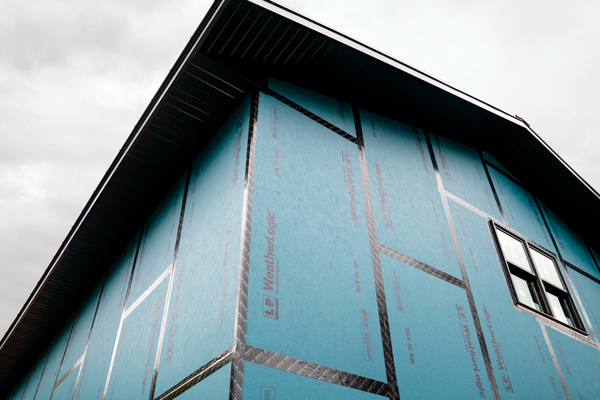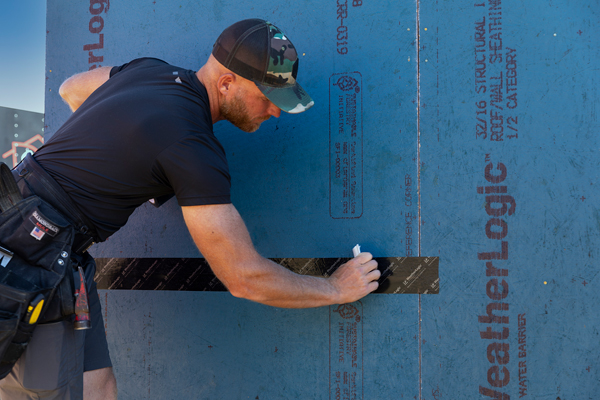Industry Trends6 min
LP WeatherLogic® Moisture Management System vs. Housewrap & Commodity OSB
When it comes to moisture management in construction, many builders default to the traditional system of using commodity OSB sheathing and housewrap. As homeowner objectives shift toward resiliency and durability, it's important to explore alternative moisture management systems that can better combat moisture concerns-not only during construction but for decades after the build. For example, can OSB boards get wet and continue to offer long-term performance similar to premium OSB products? Let's dive in and find out more.
Why Moisture Management Matters in Building Construction
Controlling moisture helps make a home more comfortable, more energy efficient and less costly to heat and cool, while helping to prevent mold growth.
As any builder knows, it's easy for small amounts of water to enter a wall cavity during construction. When water evaporates, it becomes a gas-more commonly known as water vapor-and it needs to escape. If walls can't dry out completely, a home is likely to experience mold and rot.
While fighting moisture during construction is tough, the challenge is even bigger when a family moves in. Everyday activities like washing dishes and clothes, showering and cooking create water vapor, which collects and fights to get outside.
Typically, older homes were so leaky that water vapor could easily escape. As builders learned the benefits of water barriers, the issue of moisture management moved to the forefront. Just as water needs to be barred from entering the home, moisture vapor needs a path to escape.
What Is the Main Purpose of a Water-Resistive Barrier?
OSB can get wet during normal construction periods since it's typically made with water-resistive adhesives, but a water-resistive barrier (WRB) helps protect the sheathing from future damage in the event water gets behind the exterior cladding. One benefit of a high-quality WRB is permeability so it allows water vapor to escape, helping keep a wall dry from any moisture trapped in the wall cavity.
Building code requires a WRB to be installed. While many builders opt for commodity OSB and traditional housewrap, premium moisture management systems are available, like LP WeatherLogic® Air & Water Barrier, that provide permeability and allow moisture to dry.

Commodity OSB & Traditional Housewrap vs. an Integrated WRB With Premium OSB
If new home construction is located in an area that experiences strong storms, wind and rain, using a premium integrated air and water barrier can help safeguard the home from water intrusion.
Tests like those conducted by Construction Instruction, an independent building science group, simulated a 15-minute rainstorm with 50-mph winds. The results show the commodity housewrap leaked water through the WRB and into the wall cavity. The side with LP WeatherLogic® Air & Water Barrier showed no evidence of water intrusion.
LP WeatherLogic Air & Water Barrier helps safeguard the home from water intrusion with an integrated, water-resistive overlay when all panel joints are sealed with LP's seam and flashing tape or sealant. Not only does it install like regular OSB sheathing, there's no need to go around the house a second time to add housewrap.
LP's superior limited warranty demonstrates the confidence the company has in its products. With a 30-year limited warranty, LP WeatherLogic Air & Water Barrier is proven to seal out moisture and air for years to come.
How Premium Products Can Create a Tight Seal
The final critical step in creating a water-resistant seal is to use LP's tape and sealant. Featuring one of today's highest quality adhesives, LP WeatherLogic® Tape is certified to AAMA 711-20. Tape rolls are included with panels and come in 3-3/4-inch and 6-inch widths. The wider Seam & Flashing Tape is used for window flashing and inside and outside corners. If your trades are more comfortable with sealant, LP WeatherLogic® Sealant is a liquid-applied flashing material certified to AAMA 714-19.

Wherever you build in the U.S., moisture management is a crucial consideration for long-term comfort. While traditional commodity OSB and housewrap systems are widely used, more advanced systems like integrated LP WeatherLogic Air & Water Barrier can help offer better protection against water intrusion.
For LP WeatherLogic sheathing installation tips, visit the LP WeatherLogic Installation page.
Continue Reading
Labor Solutions
5 minChoosing the Right LP® Structural Solutions Product for Your Build
When it comes to building strong, reliable, and high-performing structures, the materials you choose matter. At LP Building Solutions, we understand that every project, whether it's a single-family home or a multifamily development, requires structural components that meet your needs for strength, durability, and efficiency.
Sustainability Solutions
5 minBuilding a More Sustainable Future with LP Building Solutions
In today's world, sustainability is no longer just a buzzword, it's a blueprint for responsible living and smarter building. As the construction industry seeks ways to reduce its environmental footprint, LP Building Solutions is focused on providing innovative building materials for eco-conscious builders to help reshape what it means to build sustainably
Resiliency Solutions
5 minIntroducing LP® SmartSide® ExpertFinish® Naturals Collection™: Nature-Inspired Beauty Meets Engineered Performance
We're excited to introduce the LP® SmartSide® ExpertFinish® Naturals Collection™, a bold new addition to our trusted line of engineered wood siding and trim that delivers the warmth and beauty of nature with the advanced protection and performance builders and homeowners expect.
News & Stories3 min
History of Partnership with Gary Sinise Foundation
The LP Foundation is a proud partner of the Gary Sinise Foundation, which supports wounded veterans in several ways. You can learn more about the LP Foundation here.